Baby Flatworms Are Different From Baby Nudibranchs Because Baby Flatworms
| Nudibranch | |
|---|---|
 | |
| Berghia coerulescens | |
 | |
| Chromodoris lochi pair in Puerto Galera, the Philippines | |
| Scientific classification | |
| Kingdom: | Animalia |
| Phylum: | Mollusca |
| Course: | Gastropoda |
| Bracket: | Heterobranchia |
| Infraclass: | Euthyneura |
| Subterclass: | Ringipleura |
| Superorder: | Nudipleura |
| Guild: | Nudibranchia Cuvier, 1817 |
| Clades | |
Encounter text for superfamilies | |
| Diverseness[1] | |
| about 3000 species | |
Nudibranchs ([ii]) are a group of soft-bodied marine gastropod molluscs which shed their shells after their larval stage.[three] They are noted for their often boggling colours and striking forms, and they have been given colourful nicknames to match, such as "clown", "marigold", "splendid", "dancer", "dragon",[4] or "sea rabbit".[5] Currently, well-nigh 3,000 valid species of nudibranchs are known.[6]
The word "nudibranch" comes from the Latin nudus "naked" and the Ancient Greek βράγχια ( bránkhia ) "gills".
Nudibranchs are often casually called ocean slugs, as they are a family of opistobranchs (sea slugs), within the phylum Mollusca (molluscs), but many sea slugs belong to several taxonomic groups which are non closely related to nudibranchs. A number of these other sea slugs, such as the photosynthetic Sacoglossa and the colourful Aglajidae, are often confused with nudibranchs.
Distribution and habitat [edit]

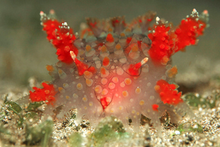
Nudibranchs occur in seas worldwide, ranging from the Arctic, through temperate and tropical regions, to the Southern ocean around Antarctica.[6] [seven] [8] They are almost entirely restricted to salt water, although a few species are known to inhabit lower salinities in brackish water.[nine]
Nudibranchs alive at virtually all depths, from the intertidal zone to depths well over 700 m (2,300 ft).[seven] The greatest diversity of nudibranchs is seen in warm, shallow reefs, although ane nudibranch species was discovered at a depth near 2,500 m (8,200 ft).[10]
Nudibranchs are benthic animals, constitute itch over the substrate.[7] The only exceptions to this are the neustonic Glaucus nudibranchs, which float upside down just under the body of water's surface; the pelagic nudibranchs Cephalopyge trematoides, which swim in the water cavalcade;[xi] [12] and Phylliroe bucephalum. [xiii]
Anatomical clarification [edit]

The trunk forms of nudibranchs vary a great deal, simply because they are opisthobranchs, unlike virtually other gastropods, they are apparently bilaterally symmetrical externally (but non internally) because they accept undergone secondary detorsion. In all nudibranchs, the male and female sexual openings are on the correct side of the body, reflecting their asymmetrical origins. They lack a mantle cavity. Some species accept venomous appendages (cerata) on their sides, which deter predators. Many also have a uncomplicated gut and a oral cavity with a radula.[fourteen]
The eyes in nudibranchs are simple and able to discern little more than than light and dark.[fifteen] The optics are prepare into the body, are about a quarter of a millimeter in bore, and consist of a lens and 5 photoreceptors.[16]
Nudibranchs vary in adult size from 4 to 600 mm (0.xvi to 23.62 in).
The adult course is without a beat out or operculum (in shelled gastropods, the operculum is a bony or horny plate that tin can comprehend the opening of the shell when the torso is withdrawn). In most species, in that location is a swimming veliger larva with a coiled beat out, only the shell is shed at metamorphosis when the larva transforms into the adult form. Some species have directly development, and the beat out is shed earlier the animal emerges from the egg mass.[xiv]
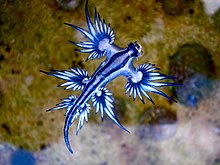
The Glaucus atlanticus is an example of a nudibranch that has its cerata positioned similar wings instead of on its dorsum.
The name nudibranch is appropriate, since the dorids (infraclass Anthobranchia) breathe through a "naked gill" shaped into branchial plumes in a rosette on their backs.[17] By contrast, on the back of the aeolids in the clade Cladobranchia, brightly coloured sets of protruding organs called cerata are present.
Nudibranchs have cephalic (head) tentacles, which are sensitive to affect, taste, and smell. Social club-shaped rhinophores detect odors.
Defence mechanisms [edit]

In the course of their development, nudibranchs have lost their shells, while developing alternative defense force mechanisms. Some species evolved an external anatomy with textures and colours that mimicked surrounding sessile invertebrate animals (often their prey sponges or soft corals) to avoid predators (camouflage). Other nudibranchs, equally seen especially well on chromodorids, have an intensely bright and contrasting colour pattern that makes them especially conspicuous in their surroundings. Nudibranch molluscs are the most commonly cited examples of aposematism in marine ecosystems, but the evidence for this has been contested,[18] mostly because few examples of mimicry are seen among species, many species are nocturnal or ambiguous, and vivid colours at the red cease of the spectrum are rapidly attenuated as a role of water depth. For example, the Spanish dancer nudibranch (genus Hexabranchus), among the largest of tropical marine slugs, potently chemically defended, and brilliantly red and white, is nocturnal and has no known mimics.[19] Other studies of nudibranch molluscs take ended they are aposematically coloured, for instance, the slugs of the family Phylidiidae from Indo-Pacific coral reefs.[twenty]
Nudibranchs that feed on hydrozoids can store the hydrozoids' nematocysts (stinging cells) in the dorsal body wall, the cerata.[21] These stolen nematocysts, called kleptocnidae, wander through the comestible tract without harming the nudibranch. Once further into the organ, the cells are alloyed past intestinal protuberances and brought to specific placements on the creature's hind body. Nudibranchs can protect themselves from the hydrozoids and their nematocysts; the specific mechanism is all the same unknown, but special cells with large vacuoles probably play an of import function. Similarly, some nudibranchs tin can also accept in plant cells (symbiotic algae from soft corals) and reuse these to brand nutrient for themselves. The related grouping of sacoglossan ocean slugs feed on algae and retain simply the chloroplasts for their own photosynthetic employ, a procedure known as kleptoplasty.
Nudibranchs use a diverseness of chemical defences to help in protection,[22] but information technology is not necessary for the strategy to be lethal to be effective; in fact, good arguments exist that chemic defences should evolve to be distasteful rather than toxic.[23] Some sponge-eating nudibranchs concentrate the chemic defences from their prey sponge in their bodies, rendering themselves distasteful to predators.[xix] [24] One method of chemical defense force used by nudibranchs are secondary metabolites, which play an important function in mediating relationships among marine communities. [25] The bear witness that suggests the chemic compounds used by dorid nudibranchs exercise in fact come from dietary sponges lies in the similarities betwixt the metabolites of prey and nudibranchs, respectively. Furthermore, nudibranchs contain a mixture of sponge chemicals when they are in the presence of multiple food sources, too as change defence chemicals with a concurrent change in diet.[26] This, however, is not the only way for nudibranchs to develop chemic defences. Sure Antarctic marine species defense mechanisms are believed to be controlled by biological factors like predation and competition, and selective pressures. [27]Certain species are able to produce their own chemicals de novo without dietary influence. Testify for the different methods of chemical production comes with the characteristic uniformity of chemical composition across drastically different environments and geographic locations institute throughout de novo production species compared to the wide variety of dietary and environmentally dependent chemical composition in sequestering species.[28]
Another method of protection is the release of an acid from the skin.[29] Once the specimen is physically irritated or touched by another creature, it will release the mucus automatically.
Apparent production of sound [edit]
In 1884, Philip Henry Gosse reported observations by "Professor Grant" (perchance Robert Edmond Grant) that 2 species of nudibranchs emit sounds that are audible to humans.[30]
Ii very elegant species of Sea-slug, viz., Eolis punctata [i.east. Facelina annulicornis], and Tritonia arborescens [i.e. Dendronotus frondosus], certainly produce aural sounds. Professor Grant, who first observed the interesting fact in some specimens of the latter which he was keeping in an aquarium, says of the sounds, that 'they resemble very much the clink of a steel wire on the side of the jar, i stroke but been given at a time, and repeated at intervals of a infinitesimal or two; when placed in a large basin of water the audio is much obscured, and is like that of a lookout man, one stroke existence repeated, equally earlier, at intervals. The sound is longest and most often repeated when the Tritonia are lively and moving virtually, and is not heard when they are common cold and without any motion; in the dark I accept not observed whatever calorie-free emitted at the time of the stroke; no globule of air escapes to the surface of the water, nor is any ripple produced on the surface at the instant of the stroke; the sound, when in a glass vessel, is mellow and distinct.' The Professor has kept these Tritonia alive in his room for a month, and during the whole flow of their confinement they have continued to produce the sounds with very lilliputian diminution of their original intensity. In a small apartment they are aural at the distance of twelve feet. The sounds patently proceed from the oral cavity of the animal; and at the instant of the stroke, we observe the lips of a sudden separate, as if to let the h2o to rush into a small vacuum formed within. As these animals are hermaphrodites, requiring mutual impregnation, the sounds may perhaps exist a means of communication betwixt them, or, if they are of an electrical nature, they may be the means of defending from foreign enemies one of the most fragile, defenceless, and beautiful Gasteropods that inhabit the deep.
Lifecycle [edit]
| | This section needs expansion. Y'all can aid by adding to it. (January 2018) |


Nudibranchs are hermaphroditic, thus having a prepare of reproductive organs for both sexes, but they cannot fertilize themselves. Mating commonly takes a few minutes, and involves a dance-like courtship. Nudibranchs typically eolith their eggs within a gelatinous spiral,[32] which is often described as looking similar a ribbon. The number of eggs varies; it can exist equally few every bit just 1 or two eggs (Vayssierea felis) or as many as an estimated 25 million (Aplysia fasciata{not a nudibranch}). The eggs contain toxins from sea sponges equally a means of deterring predators.[33] After hatching, the infants look almost identical to their adult counterparts, albeit smaller. Infants may too have fewer cerata. The lifespan of nudibranchs can range from a few weeks to a year, depending on the species.
Feeding and ecological function [edit]

All known nudibranchs are cannibal. Some feed on sponges, others on hydroids (e.thousand. Cuthona),[34] others on bryozoans (phanerobranchs such as Tambja, Limacia, Plocamopherus and Triopha),[35] and some eat other sea slugs or their eggs (e.g. Favorinus)[36] or, on some occasions, are cannibals and casualty on members of their own species. Other groups feed on tunicates (e.g. Nembrotha, Goniodoris),[37] other nudibranchs (Roboastra, which are descended from tunicate-feeding species),[37] barnacles (e.g. Onchidoris bilamellata),[38] and anemones (e.g. the Aeolidiidae and other Cladobranchia).[35]
The surface-dwelling nudibranch, Glaucus atlanticus, is a specialist predator of siphonophores, such as the Portuguese man o' war. This predatory mollusc sucks air into its stomach to go on it afloat, and using its muscular human foot, it clings to the surface film. If information technology finds a small victim, Glaucus merely envelops it with its capacious mouth, but if the prey is a larger siphonophore, the mollusc nibbles off its line-fishing tentacles, the ones carrying the virtually strong nematocysts. Like some others of its kind, Glaucus does not digest the nematocysts; instead, information technology uses them to defend itself by passing them from its gut to the surface of its peel.[39]
Taxonomy [edit]
![]()
Dorids (Chromodoris willani shown) exhale with the branchial plumage, which projects from effectually their anus.
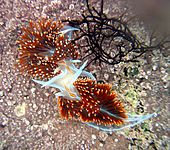
Aeolids (Hermissenda crassicornis pictured) have many cerata over their back which are used for defense and respiration.
Nudibranchs are frequently differentiated as either dorid or aeolid.
Nudibranchs are commonly divided into two chief kinds, dorid and aeolid (also spelled eolid) nudibranchs:[xl] [41]
- Dorids (clade Anthobranchia, Doridacea, or Doridoidea) are recognised by having an intact digestive gland and the feather-like branchial (gill) plume, which forms a cluster on the posterior part of the body, effectually the anus. Fringes on the mantle exercise not incorporate any intestines.[ citation needed ] Additionally, dorid nudibranchs commonly accept distinct pockets, bumps, and/or drapery dermal formations, which are distortions on their skin, used to shop bioactive defense chemicals.[42]
- Aeolids (clade Cladobranchia) have cerata (spread across the back) instead of the branchial plume. The cerata role in place of gills and facilitate gas exchange through the epidermis. Additionally, aeolids possess a branched digestive gland, which may extend into the cerate and often has tips that incorporate cnidosacs (stinging cells captivated from casualty species so used by the nudibranch).[43] They lack a mantle.[ commendation needed ] Some are hosts to zooxanthellae.
The exact systematics of nudibranchs are a topic of recent revision. Traditionally, nudibranchs have been treated as the lodge Nudibranchia, located in the gastropod mollusc bracket Opisthobranchia (the marine slugs: which consisted of nudibranchs, sidegill slugs, chimera snails, algae sap-sucking sea slugs, and sea hares).[forty] Since 2005,[44] pleurobranchs (which had previously been grouped among sidegill slugs) take been placed alongside nudibranchs in the clade Nudipleura (recognising them as more than closely related to each other than to other opisthobranchs).[45] Since 2010, Opisthobranchia has been recognised as not a valid clade (it is paraphyletic) and instead Nudipleura has been placed every bit the first adjunct of Euthyneura (which is the dominant clade of gastropods).[46]
Traditional hierarchy [edit]
This classification was based on the work of Johannes Thiele (1931),[47] who congenital on the concepts of Henri Milne-Edwards (1848).[48]
Guild Nudibranchia:
- Infraorder Anthobranchia Férussac, 1819 (dorids)
- Superfamily Doridoidea Rafinesque, 1815
- Superfamily Doridoxoidea Bergh, 1900
- Superfamily Onchidoridoidea Alder & Hancock, 1845
- Superfamily Polyceroidea Alder & Hancock, 1845
- Infraorder Cladobranchia Willan & Morton, 1984 (aeolids)
- Superfamily Aeolidioidea J. E. Gray, 1827
- Superfamily Arminoidea Rafinesque, 1814
- Superfamily Dendronotoidea Allman, 1845
- Superfamily Metarminoidea Odhner in Franc, 1968
Early revisions [edit]
Newer insights derived from morphological information and gene-sequence research seemed to confirm those ideas. On the ground of investigation of 18S rDNA sequence data, strong evidence supports the monophyly of the Nudibranchia and its two major groups, the Anthobranchia/Doridoidea and Cladobranchia.[49] A study published in May 2001, again revised the taxonomy of the Nudibranchia.[50] They were thus divided into ii major clades:
- Anthobranchia (= Bathydoridoidea + Doridoidea)
- Dexiarchia nom. nov. (= Doridoxoidea + Dendronotoidea + Aeolidoidea + "Arminoidea").
However, according to the taxonomy by Bouchet & Rocroi (2005), currently the well-nigh upwards-to-date system of classifying the gastropods, the Nudibranchia are a subclade inside the clade of the Nudipleura. The Nudibranchia are then divided into two clades:
- Euctenidiacea (= Holohepatica)
- Gnathodoridacea (contains just Bathydorididae)
- Doridacea
- Doridoidea
- Phyllidioidea
- Onchidoridoidea
- Polyceroidea (= Phanerobranchiata Not Suctoria)
- Dexiarchia (= Actenidiacea)
- Pseudoeuctenidiacea ( = Doridoxida)
- Cladobranchia ( = Cladohepatica)
- Euarminida
- Dendronotida
- Aeolidida
- Unassigned Cladobranchia (previously Metarminoidea)
- Charcotiidae
- Dironidae
- Goniaeolididae
- Heroidae
- Proctonotidae
- Madrellidae
- Pinufiidae
- Embletoniidae
Gallery [edit]
This gallery shows some of the great variability in the color and form of nudibranchs, and nudibranch egg ribbons.
-

-

-
-
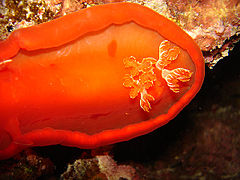
Castilian dancer taken at nighttime, Red Sea
-
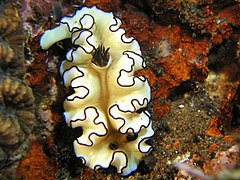
-
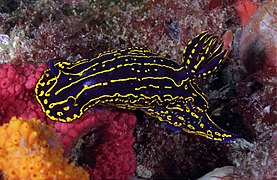
Majestic sea goddess Felimare picta in the Gray'due south Reef National Marine Sanctuary, Savannah, Georgia
-
Dorid nudibranch egg ribbon in Moss Embankment, California
-

-

Nudibranch
See also [edit]
- Symposia and workshops on opisthobranchs
References [edit]
- ^ Wägele, H.; Klussmann-Kolb, A. (2005). "Opisthobranchia (Mollusca, Gastropoda) more but slimy slugs. Shell reduction and its implications on defense force and foraging". Frontiers in Zoology. 2 (one): 1–18. doi:10.1186/1742-9994-2-3. PMC554092. PMID 15715915.
- ^ Longman Pronunciation Lexicon (2nd edition), ISBN 0-582-36467-1
- ^ Thompson, T. Due east. (2009). "Feeding in nudibranch larvae" (PDF). Periodical of the Marine Biological Association of the United Kingdom. 38 (ii): 239–248. doi:10.1017/S0025315400006044.
- ^ Turnbull, John (Spring 2016). "The Nudibranch - Creature Feature". Nature New South Wales. 60 (three): 16–17.
- ^ Bronson, Wilfrid. Water People, 1935
- ^ a b Ocean Portal (2017). A Collage of Nudibranch Colors. Smithsonian National Museum of Natural History. Retrieved 17 April 2018.
- ^ a b c Nudibranchs, Fishermen Scuba.
- ^ Ekimova, I.; T. Korshunova; D. Schepetov; T. Neretina; North. Sanamyan; A. Martynov (2015). "Integrative systematics of northern and Chill nudibranchs of the genus Dendronotus (Mollusca, Gastropoda), with descriptions of three new species". Zoological Periodical of the Linnean Society. 173 (4): e0192177. doi:10.1111/zoj.12214.
- ^ Korshunova, T.; K. Lundin; K. Malmberg; B. Picton; A. Martynov (2018). "Start true stagnant-water nudibranch mollusc provides new insights for phylogeny and biogeography and reveals paedomorphosis-driven evolution". PLOS ONE. 13 (1): e0192177. Bibcode:2018PLoSO..1392177K. doi:ten.1371/journal.pone.0192177. PMC5851531. PMID 29538398.
- ^ "Discoveries of deep-ocean biomass and biodiversity using an ROV". Monterey Bay Aquarium Research Institute. Archived from the original on 9 October 2013. Retrieved 16 October 2013.
- ^ Steinberg, J. E. (1956). "The pelagic nudibranch, Cephalopyge trematoides (Chun, 1889), in New South Wales with a note on other species in this genus". Proceedings of the Linnean Society of New South Wales. 81: 184–192.
- ^ G.M. Mapstone & M.N. Arai, Siphonophora (Cnidaria, Hydrozoa) of Canadian Pacific Waters, p.33. "The best documented predators of pelagic cnidarians from the phylum Mollusca are the neustonic nudibranchs and snails [...and] the pelagic nudibranch [...]"
- ^ Gosliner TM, Valdes A Behrens DW 2015 Nudibranch and Sea Slug Identification Indo-Pacific New World Publications Jacksonville Florida USA
- ^ a b Thompson, T. E. 1976. Biological science of opisthobranch molluscs, vol. one, 207 pp., 21 pls. Ray Gild, no. 151.
- ^ "Nudibranchs – National Geographic Magazine". Ngm.nationalgeographic.com. 2013-04-25. Retrieved 2013-07-04 .
- ^ Chase, RONALD (June 1, 1974). "The Electrophysiology of Photoreceptors in the Nudibranch Mollusc, Tritonia Diomedia". Journal of Experimental Biological science. 60 (iii): 707–19. doi:10.1242/jeb.60.3.707. PMID 4847278.
- ^ Dayrat, B. (2005). "Advantages of naming species under the PhyloCode: An instance of how a new species of Discodorididae (Mollusca, Gastropoda, Euthyneura, Nudibranchia, Doridina) may be named" (PDF). Marine Biology Enquiry. 1 (3): 216–232. doi:10.1080/17451000510019141. S2CID 53557429. Retrieved 2009-06-14 .
- ^ Edmunds, M. (1991). "Does alert colouration occur in nudibranchs?". Malacologia. 32: 241–255.
- ^ a b Pawlik, JR; et al. (1988). "Defensive chemicals of the Spanish Dancer nudibranch, Hexabranchus sanguineus, and its egg ribbons: Macrolides derived from a sponge diet". Journal of Experimental Marine Biological science and Ecology. 119 (ii): 99–109. doi:10.1016/0022-0981(88)90225-0.
- ^ Ritson-Williams, R.; Paul, VJ (2007). "Marine benthic invertebrates utilize multimodal cues for defence against reef fish". Marine Environmental Progress Series. 340: 29–39. Bibcode:2007MEPS..340...29R. doi:ten.3354/meps340029.
- ^ Frick, Chiliad (2003). "Predator Suites and Flabellinid Nudibranch Nematocyst Complements in the Gulf of Maine". In: SF Norton (Ed). Diving for Science...2003. Proceedings of the American Academy of Underwater Sciences (22nd Annual Scientific Diving Symposium). Retrieved 2008-07-03 .
- ^ Karuso, P. (1987). "Chemical Ecology of the Nudibranchs". In Scheuer, PJ (ed.). Bioorganic Marine Chemistry. Vol. ane. Springer-Verlag. pp. 31–threescore. doi:10.1007/978-3-642-72726-9_2. ISBN978-three-642-72728-3. , a comprehensive review of the chemical ecology of the nudibranchs
- ^ Pawlik, JR (2012). Fattorusso, E.; et al. (eds.). Antipredatory defensive roles of natural products from marine invertebrates. Handbook of Marine Natural Products. NY: Springer Science. pp. 677–710.
- ^ Gosliner, T. M. (1987). Nudibranchs of Southern Africa. ISBN978-0-930118-13-6.
- ^ Avila, C; Iken, Thousand; Fontana, A; Cimino, G (2000-09-05). "Chemical environmental of the Antarctic nudibranch Bathydoris hodgsoni Eliot, 1907: defensive office and origin of its natural products". Journal of Experimental Marine Biology and Ecology. 252 (1): 27–44. doi:10.1016/S0022-0981(00)00227-6. ISSN 0022-0981. PMID 10962063.
- ^ Faulkner, D. J.; Ghiselin, M. T. (1983). "Chemic defence force and evolutionary ecology of dorid nudibranchs and some other opisthobranch gastropods". Marine Ecology Progress Series. 13: 295–301. Bibcode:1983MEPS...13..295F. doi:10.3354/meps013295.
- ^ Avila, C; Iken, K; Fontana, A; Cimino, One thousand (2000-09-05). "Chemical ecology of the Antarctic nudibranch Bathydoris hodgsoni Eliot, 1907: defensive role and origin of its natural products". Periodical of Experimental Marine Biological science and Environmental. 252 (1): 27–44. doi:10.1016/S0022-0981(00)00227-6. ISSN 0022-0981. PMID 10962063.
- ^ Barsby, T.; Linington, R. K.; Andersen, R. J. (2002). "De Novo terpenoid biosynthesis by the dendronotid nudibranch Melibe leonina". Chemoecology. 12 (4): 199–202. doi:10.1007/PL00012669. S2CID 35384332.
- ^ Edmunds, Thousand. (1968). "Acid secretion in some species of Doridacea (Mollusca, Nudibranchia)". Proceedings of the Malacological Society of London. 38 (2): 121–133. Archived from the original on 2013-04-15.
- ^ P.H. Gosse, Evenings at the Microscope, 1884 edition,[ane] p57
- ^ Klussmann-Kolb A (2001). "The Reproductive Systems of the Nudibranchia (Gastropoda, Opisthobranchia): Comparative Histology and Ultrastructure of the Nidamental Glands with Aspects of Functional Morphology". Zoologischer Anzeiger. 240 (2): 119–136. doi:10.1078/0044-5231-00011.
- ^ "Diving with Nudibranchs". Dive the Earth.
- ^ NC Folino (1997). "The role of casualty mobility in the population ecology of the nudibranch Cuthona nana (Gastropoda: Opisthobranchia)" (PDF). American Malacological Message. Archived from the original (PDF) on 2012-06-25. Retrieved 2013-03-07 .
- ^ a b Domínguez, Thousand.; Troncoso, J. S.; García, F. J. (2008). "The family unit Aeolidiidae Gray, 1827 (Gastropoda Opisthobranchia) from Brazil, with a description of a new species belonging to the genus Berghia Trinchese, 1877". Zoological Journal of the Linnean Guild. 153 (2): 349–368. doi:x.1111/j.1096-3642.2008.00390.x.
- ^ Rudman, W.B. (1999-03-xix). "Favorinus tsuruganus Baba & Abe, 1964. [In] Ocean Slug Forum. Australian Museum".
- ^ a b Valdés, Á. (2004). "Phylogeography and phyloecology of dorid nudibranchs (Mollusca, Gastropoda)". Biological Journal of the Linnean Social club. 83 (four): 551–559. doi:10.1111/j.1095-8312.2004.00413.x.
- ^ Barnes, H.; Powell, H. T. (1954). "Onchidoris fusca (Müller); A Predator of Barnacles". Periodical of Beast Ecology. 23 (two): 361–363. doi:10.2307/1986. JSTOR 1986.
- ^ Piper, Ross (2007), Boggling Animals: An Encyclopedia of Curious and Unusual Animals, Greenwood Press.
- ^ a b Hans Bertsch, Nudibranchs: Marine slugs with verve. "Navanax inermis[..] is the blight of all nudibranchs, because it is one of the few known predators on this group of slugs. [...] Dorids mainly eat sponges, bryozoans, and tunicates, whereas aeolids principally eat cnidarians."
- ^ "Facts About Nudibranchs". Marinelife.most.com. 2011-11-10. Retrieved 2013-07-04 .
- ^ Dean, Lewis J.; Prinsep, Michèle R. (2017). "The chemistry and chemical environmental of nudibranchs". Natural Product Reports. 34 (12): 1359–1390. doi:10.1039/C7NP00041C. ISSN 0265-0568. PMID 29135002.
- ^ Cella, Kristen; Carmona, Leila; Ekimova, Irina; Chichvarkhin, Anton; Schepetov, Dimitry; Gosliner, Terrence 1000. (2016-12-15). "A Radical Solution: The Phylogeny of the Nudibranch Family Fionidae". PLOS I. 11 (12): e0167800. Bibcode:2016PLoSO..1167800C. doi:10.1371/journal.pone.0167800. ISSN 1932-6203. PMC5158052. PMID 27977703.
- ^ Taxonomy of the Gastropoda, Bouchet & Rocroi, 2005
- ^ Poppe, Guido T.; Tagaro, Sheila P. (February 23, 2006). "The New Nomenclature of Gastropods according to Bouchet & Rocroi, 2005" (PDF). Visaya. Archived from the original (PDF) on September 27, 2007.
- ^ Jörger, Yard. Grand.; Stöger, I.; Kano, Y.; et al. (2010). "On the origin of Acochlidia and other enigmatic euthyneuran gastropods, with implications for the systematics of Heterobranchia". BMC Evolutionary Biology. 10: 323. doi:x.1186/1471-2148-10-323. PMC3087543. PMID 20973994.
At the basis of the Euthyneura the Nudipleura split off
- ^ Thiele, J. (1931). Handbuch der systematischen Weichtierkunde, II. Verlag von Gustav Fischer, Jena, Frg.
- ^ Milne-Edwards H (1848). Annotation sur la nomenclature naturelle chez Mollusques Gasteropodes. Annales des Sciences Naturelles, serial 3, ix: 102-112.
- ^ Wägele H. & Willan R. C. (September 2000). "Phylogeny of the Nudibranchia". Zoological Journal of the Linnean Society. 130 (1): 83–181. doi:ten.1111/j.1096-3642.2000.tb02196.x.
- ^ Schrödl M., Wägele H. & Willan R. C. (2001). "Taxonomic Redescription of the Doridoxidae (Gastropoda: Opisthobranchia), an Enigmatic Family of Deep H2o Nudibranchs, with Discussion of Basal Nudibranch Phylogeny". Zoologischer Anzeiger. 240 (1): 83–97. doi:x.1078/0044-5231-00008.
Farther reading [edit]
- Thompson, T. East. (1976). Biology of opisthobranch molluscs Vol. one. 207 pp., 21 pls. Ray Club, no. 151.
- Thompson, T. Eastward., & M. H. Brown (1984). Biology of opisthobranch molluscs Vol. 2. 229 pp., 41 pls. Ray Order, no. 156.
- McDonald, Gary R. (7 July 2021). Institute of Marine Sciences. Bibliographia Nudibranchia, tertiary online Edition. A listing, by Author, of publications on nudibranchs.
- McDonald, Gary R. (7 July 2021). Institute of Marine Sciences. Nudibranch Systematic Alphabetize, 3rd online Edition. An alphabetize of names given to nudibranchs and their subsequent utilize, referenced to Bibliographia Nudibranchia.
- McDonald, Gary R. & J. West. Nybakken. (November 5, 2014). List of the Worldwide Food Habits of Nudibranchs
- Coleman, Neville (2008). Nudibranchs Encyclopedia: Catalogue of Asia/Indo-Pacific Sea Slugs. Neville Coleman'southward Underwater Geographic. ISBN 0-947325-41-7
External links [edit]
- Body of water Slug Forum by William B. Rudman
- Nudibranchs of the British Isles
- OPK Opistobranquis – Iberian and Mediterranean Opisthobranchs
- Mediterranean slug site (actually a misnomer – Worldwide coverage
- The Slug Site, Michael D. Miller 2002–2014
- The Okinawa Slug Site
- Images, information and identification of Nudibranchs
- Nudibranch Photos by Mick Tait
- Nudibranchs in their natural surround, Scuba Diving – Narooma NSW offline? 26 November 2014
- Nudi Pixel: Online resource for nudibranchs and sea slugs identification using photographs
- Diverse nudibranch species from Indonesia, Philippines and Thailand
- Nudibranch gallery- Sergey Parinov – offline? 26 Nov 2014
- Opisthobranch Newsletter – Bibliography and portal to opisthobranch, nudibranch & seaslug information
- Scottish Nudibranchs: Online resources for identification of species plant in Scottish waters
- National Geographic Nudibranch Photo Gallery
- Body of water Slugs of Hawaii
- Slug City – Molluscs. Encephalon & Behavior, from the University of Illinois at Urbana-Champaign
Videos [edit]
- Attack of the Body of water Slugs at YouTube
- The Lynx Nudibranch: Hard disk prune of Phidiana lynceus carefully consuming a hydroid Myrionema amboinense.
- Slug City – Molluscs. Brain & Behavior: many videos of nudibranchs from the University of Illinois at Urbana-Champaign
Source: https://en.wikipedia.org/wiki/Nudibranch


0 Response to "Baby Flatworms Are Different From Baby Nudibranchs Because Baby Flatworms"
Post a Comment